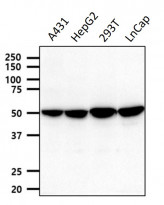ARG57546
anti-PDHX / Pyruvate dehydrogenase antibody [1E11]
anti-PDHX / Pyruvate dehydrogenase antibody [1E11] for Western blot and Human
Overview
| Product Description | Mouse Monoclonal antibody [1E11] recognizes PDHX / Pyruvate dehydrogenase |
|---|---|
| Tested Reactivity | Hu |
| Tested Application | WB |
| Host | Mouse |
| Clonality | Monoclonal |
| Clone | 1E11 |
| Isotype | IgG1, kappa |
| Target Name | PDHX / Pyruvate dehydrogenase |
| Antigen Species | Human |
| Immunogen | Recombinant Human PDHX (aa. 54-501) purified from E. coli. |
| Conjugation | Un-conjugated |
| Alternate Names | Lipoyl-containing pyruvate dehydrogenase complex component X; OPDX; proX; E3-binding protein; Dihydrolipoamide dehydrogenase-binding protein of pyruvate dehydrogenase complex; E3BP; PDX1; Pyruvate dehydrogenase protein X component, mitochondrial; DLDBP |
Application Instructions
| Application Suggestion |
|
||||
|---|---|---|---|---|---|
| Application Note | * The dilutions indicate recommended starting dilutions and the optimal dilutions or concentrations should be determined by the scientist. |
Properties
| Form | Liquid |
|---|---|
| Purification | Purification with Protein A. |
| Buffer | PBS (pH 7.4), 0.02% Sodium azide and 10% Glycerol. |
| Preservative | 0.02% Sodium azide |
| Stabilizer | 10% Glycerol |
| Concentration | 1 mg/ml |
| Storage Instruction | For continuous use, store undiluted antibody at 2-8°C for up to a week. For long-term storage, aliquot and store at -20°C. Storage in frost free freezers is not recommended. Avoid repeated freeze/thaw cycles. Suggest spin the vial prior to opening. The antibody solution should be gently mixed before use. |
| Note | For laboratory research only, not for drug, diagnostic or other use. |
Bioinformation
| Database Links |
Swiss-port # O00330 Human Pyruvate dehydrogenase protein X component, mitochondrial |
|---|---|
| Gene Symbol | PDHX |
| Gene Full Name | pyruvate dehydrogenase complex, component X |
| Background | The pyruvate dehydrogenase (PDH) complex is located in the mitochondrial matrix and catalyzes the conversion of pyruvate to acetyl coenzyme A. The PDH complex thereby links glycolysis to Krebs cycle. The PDH complex contains three catalytic subunits, E1, E2, and E3, two regulatory subunits, E1 kinase and E1 phosphatase, and a non-catalytic subunit, E3 binding protein (E3BP). This gene encodes the E3 binding protein subunit; also known as component X of the pyruvate dehydrogenase complex. This protein tethers E3 dimers to the E2 core of the PDH complex. Defects in this gene are a cause of pyruvate dehydrogenase deficiency which results in neurological dysfunction and lactic acidosis in infancy and early childhood. This protein is also a minor antigen for antimitochondrial antibodies. These autoantibodies are present in nearly 95% of patients with the autoimmune liver disease primary biliary cirrhosis (PBC). In PBC, activated T lymphocytes attack and destroy epithelial cells in the bile duct where this protein is abnormally distributed and overexpressed. PBC eventually leads to cirrhosis and liver failure. Alternative splicing results in multiple transcript variants encoding distinct isoforms.[provided by RefSeq, Oct 2009] |
| Function | Required for anchoring dihydrolipoamide dehydrogenase (E3) to the dihydrolipoamide transacetylase (E2) core of the pyruvate dehydrogenase complexes of eukaryotes. This specific binding is essential for a functional PDH complex. [UniProt] |
| Calculated MW | 54 kDa |
| PTM | Delipoylated at Lys-97 by SIRT4, delipoylation decreases the PHD complex activity. [UniProt] |
Images (1) Click the Picture to Zoom In






